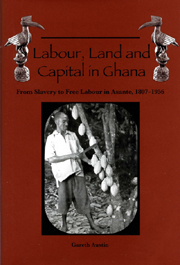Book contents
- Frontmatter
- Contents
- List of Illustrations
- List of Tables
- Preface
- Note on Names
- Maps
- Note on the Maps
- 1 Introduction
- Part I Context and Concepts
- Part II Social Relations of Production and Trade, 1807–1896: Absent and Imperfect Factor Markets
- Part III Slavery as Hobson's Choice: An Analysis of the Interaction of Markets and Coercion in Asante's Era of ‘Legitimate Commerce’, 1807–1896
- Part IV The Decline of Coercion in the Factor Markets of Colonial Asante: Cocoa and the Ending of Slavery, Pawnship and Corvée, 1896–c.1950
- Part V Social Relations of Production and Trade, 1908–1956: Towards Integrated Factor Markets?
- Part VI Freedom and Forest Rent, 1908–1956
- Abbreviations Used in the Notes
- Notes
- List of References
- Index
Part IV - The Decline of Coercion in the Factor Markets of Colonial Asante: Cocoa and the Ending of Slavery, Pawnship and Corvée, 1896–c.1950
Published online by Cambridge University Press: 12 September 2012
- Frontmatter
- Contents
- List of Illustrations
- List of Tables
- Preface
- Note on Names
- Maps
- Note on the Maps
- 1 Introduction
- Part I Context and Concepts
- Part II Social Relations of Production and Trade, 1807–1896: Absent and Imperfect Factor Markets
- Part III Slavery as Hobson's Choice: An Analysis of the Interaction of Markets and Coercion in Asante's Era of ‘Legitimate Commerce’, 1807–1896
- Part IV The Decline of Coercion in the Factor Markets of Colonial Asante: Cocoa and the Ending of Slavery, Pawnship and Corvée, 1896–c.1950
- Part V Social Relations of Production and Trade, 1908–1956: Towards Integrated Factor Markets?
- Part VI Freedom and Forest Rent, 1908–1956
- Abbreviations Used in the Notes
- Notes
- List of References
- Index
Summary
Having argued that in the nineteenth century labour and capital markets depended for their existence upon coercion, in the social form of various categories of property rights over people, in the next three chapters I examine the transition to a situation in which factor markets could and did operate largely through economic imperatives and incentives. The ending of slavery and pawning occurred under colonial rule and during the growth of export agriculture. In this the Asante experience—much neglected in the literature—has many parallels with other parts of West Africa and beyond. This part has three aims, each significant for the general and comparative discussion of the end of property rights in people. First, by means of an unusually full analysis of the motivation of colonial policy (Chapter 11), it attempts to sharpen our understanding of why prohibition was long delayed. The term ‘prohibition’ is used advisedly: as will be seen, the measures taken against slavery and pawn-ing (as distinct from slave trading) had none of the terminal efficacy connoted by ‘abolition’. Accordingly, the second aim is to unravel some of the many strands of the decline of slavery and pawning ‘on the ground’ and to relate them to the trajectories of the other coercive institutions of labour mobilization (Chapter 12). The third aim is to examine the historical relationship(s), if any, between coerced labour and the development of the cash-crop economy (Chapter 13).
- Type
- Chapter
- Information
- Labour, Land and Capital in GhanaFrom Slavery to Free Labour in Asante, 1807–1956, pp. 203 - 204Publisher: Boydell & BrewerPrint publication year: 2005

